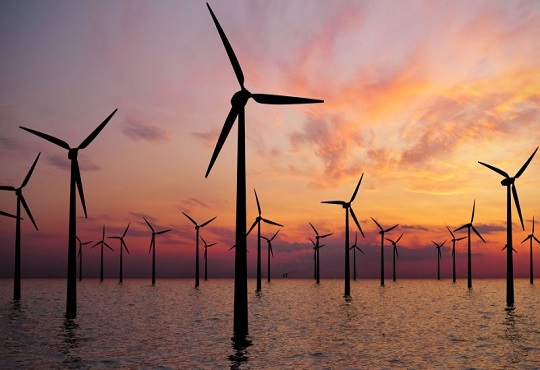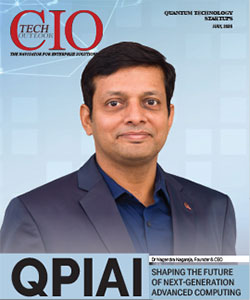Harnessing the Potential of Deep Tech in the Energy Sector
Janifha Evangeline, Assistant Editor, CIOTechOutlook | Saturday, 09 December 2023, 13:13 IST

A team of scientists from IIT Madras in India has successfully secured a patent for an innovative 'Combined Power Generation Technology'. This groundbreaking technology has the capability to produce electricity using both tidal and wind energy sources. This has the capability to function as a movable vehicle for generating, transmitting, and storing power.
The innovation is a system for converting energy that produces electricity in coastal regions, aiming to decrease the need for electricity. Depending on the power needs in the coastal region, the converter system can be implemented. The researchers have their attention and efforts directed towards scalability and affordability. They are aiming to construct a low-cost prototype utilizing 3D-Printing and other technological methods.
Commenting on a timeline for possible field deployment of this unique technology A Seshadri Sekhar, a former Head, Department of Mechanical Engineering, IIT Madras, who is currently on deputation to IIT Palakkad as its Director said, “The converter system may need to be relocated depending on the power demand in the coastal area. The system’s or gadget’s energy output is fully renewable.”
The power sector is at a critical juncture, facing the dual challenges of meeting the growing global energy demand and transitioning towards sustainable, low-carbon alternatives. Deep technologies, encompassing artificial intelligence (AI), machine learning (ML), Internet of Things (IoT), and blockchain, are emerging as transformative forces capable of reshaping the energy landscape. This article explores the untapped potential of deep tech in the power sector, discussing its applications, benefits, and the imperative for strategic integration.
Smart Grids and Energy Management
One of the prominent applications of deep tech in the power sector is the development of smart grids. AI and ML algorithms can optimize grid operations, enhance reliability, and facilitate real-time energy monitoring. Through predictive analytics, these technologies enable proactive maintenance, reducing downtime and increasing overall efficiency. Moreover, IoT sensors integrated into the grid infrastructure provide valuable data for comprehensive energy management.
Esyasoft Technologies was founded with the aim of fostering intelligent solutions for the interconnected world, providing comprehensive support to utilities in order to effectively support future business operations.
“The Intelligent Smart Grid Platform has been developed with an understanding of the issues faced by utilities and a back-end team of seasoned analytics professionals and domain experts,” says Bipin Chandra, Founder & CEO, EsyaSoft Technologies.
Renewable Energy Integration & Energy storage solutions
Deep tech plays a pivotal role in integrating renewable energy sources into the power grid seamlessly. AI algorithms can forecast renewable energy generation patterns, allowing for better grid balancing and energy storage utilization. ML models optimize the performance of solar and wind farms by predicting output fluctuations and adjusting operations accordingly. This not only improves grid stability but also promotes the efficient use of renewable resources.
The development of advanced energy storage solutions is critical for addressing the intermittent nature of renewable energy sources. Deep tech facilitates the optimization of energy storage systems through intelligent control mechanisms. Blockchain technology ensures transparency and security in energy transactions, fostering decentralized energy storage networks. This not only enhances grid resilience but also enables distributed energy resources to play a more significant role in the power ecosystem.
Proxima Fusion - a European company involved in the development of the initial series of fusion power plants utilizing QI stellarators. With certain key innovations, we are leveraging decades of progress in magnetic confinement fusion to bring fusion energy into the grid.
Empowering utilities to implement demand response programs
Deep tech empowers utilities to implement demand response programs effectively. AI-driven demand forecasting models enable utilities to anticipate peak demand periods, allowing for better load management. Moreover, smart meters and IoT devices enable real-time communication with consumers, promoting energy conservation and efficient consumption. These technologies enhance customer engagement, providing end-users with the tools to actively participate in the energy transition.
The Mobility House has been working on technologies that harness the complete capabilities of electric vehicle batteries, both mobile and stationary, by implementing ideal charging and integrating them into the energy market.
Cybersecurity and Grid Resilience
As the power sector becomes increasingly digitized, ensuring cybersecurity is paramount. Deep tech solutions, including AI-driven threat detection and blockchain-based security protocols, fortify the resilience of power grids against cyber-attacks. Continuous monitoring and adaptive security measures are essential components in safeguarding critical infrastructure, preventing disruptions, and maintaining the integrity of the energy supply chain.
Piclo develops cutting-edge software solutions that contribute to the advancement of intelligent, adaptable, and environmentally friendly electricity grids. We have a global reputation as the industry leader in local flexibility markets, with our products being utilized by buyers and sellers in six different countries.
Joe Athialy, Executive Director of the Centre for Financial Accountability, highlighted the changing economics of energy production. “Cost of renewable energy with storage is now comparable and cheaper than new coal plant construction, irrespective of the location. Besides losing out to renewable energy on per unit cost of electricity, coal power plants will have to be retired within a decade from now”.
“Financial institutions are reluctant to fund coal projects, be it power plant construction or coal mining, knowing fully well that the global outlook on coal remains heavily in the negative,” he added.
The power sector stands on the cusp of a technological revolution, where the integration of deep tech can address longstanding challenges and pave the way for a more sustainable and resilient energy future. Harnessing the full potential of AI, ML, IoT, and blockchain in smart grids, renewable energy integration, energy storage, demand response, customer engagement, and cybersecurity is imperative. Governments, industry stakeholders, and research institutions must collaborate to create a conducive environment for innovation, investment, and the widespread adoption of deep tech solutions. As we navigate the complexities of the energy transition, leveraging deep tech will not only optimize existing processes but also unlock new possibilities, steering the power sector towards a more efficient, flexible, and sustainable future.




